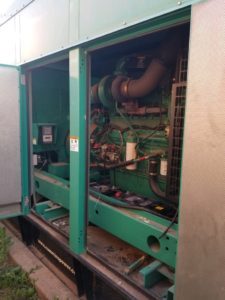A Simple Explanation of the Generator Load Sharing Principle
 The generator load sharing principle is crucial to understand when attempting to parallel generators at any facility, including data centers and power plants. This is because different manufacturers’ load sharing controls may not be compatible and overloading or underloading each unit must be avoided for successful and efficient generator paralleling. There are several different ways in which efficient generator load sharing may be accomplished, such as reactive droop compensation, cross-current compensation and using different operating modes.
The generator load sharing principle is crucial to understand when attempting to parallel generators at any facility, including data centers and power plants. This is because different manufacturers’ load sharing controls may not be compatible and overloading or underloading each unit must be avoided for successful and efficient generator paralleling. There are several different ways in which efficient generator load sharing may be accomplished, such as reactive droop compensation, cross-current compensation and using different operating modes.
What Is Load Sharing?
In simple terms, load sharing is the process at which a facility operates multiple generators at the same time. In technical terms, load sharing is the proportional division of active power and reactive power between generator sets. Parallel operation and load sharing are closely related. A system of generator sets cannot achieve parallel operation without load sharing of alternators.
Parallel operation is a way to increase power generation by aligning the electrical qualities of multiple generator sets. Many operations rely on parallel generator sets to improve their capacity and meet high energy output demands.
When the load is not shared between your network of generator sets, you risk overloading an alternator or creating an unstable energy flow. This instability can damage your generator sets or power grid.
GENERATOR LOAD SHARING PRINCIPLE EXAMPLES
Although the generator load sharing principle may seem complicated, taking a closer look at different methods of generator load sharing can help to make things more clear. For example, types of load sharing include:
- Droop Load Sharing: Reactive droop compensation “allows the engine speed or alternator voltage to decline by a predetermined percentage of the output range as the load increases” (Cummins Power Generation).
- Isochronous kW and kVAR Load Sharing: Isochronous systems make use of controls to calculate load information and determine how the percentage of the generators’ load compares to the system load. kW refers to real power sharing whereas kVAR refers to reactive power; both kW and kVAR loads are calculated by control systems in order to sufficiently share loads between generators.
- Cross Current Compensation: When paralleled generators are run without intentional voltage droop, cross-current compensation occurs. Voltage regulators on each generator unit should be identical for successful load sharing.
- Using Different Operating Modes: By utilizing single board paralleling controllers it becomes much easier to successfully add generators to existing systems as well as to complete upgrades to systems. Single board paralleling controllers also make it possible to operate paralleled generators in different load level modes (some generators may be set to a base, constant mode while other designated units will float and share loads as needed).
Proper generator load sharing is essential for the success of a parallel generator system and in turn for backup power. In case of emergencies when power failure occurs, redundancy is vital to keep mission-critical functions running without fail. Be sure to review different methods of and basics of the generator load sharing principle to find the best solution for your particular power generator needs. It can also be helpful to review before purchasing generators to help understand which units will be easily compatible for a paralleling set.
The Benefits of Load Sharing
Parallel operation and load sharing offer a range of benefits to anyone who uses them. Some advantages include:
- Reliability: With multiple alternators in a network, there will always be at least one generator set supporting a load. If an alternator fails at any point, the load will shift to the other generators in the system. Load sharing also makes it easier to handle generator maintenance without shutting down an entire operation.
- Cost: The cost to generate power increases for larger capacity generators. Using a network of smaller generators means spending less money upfront and paying less to generate power over time. With multiple alternators, operators can determine the best load balance for the least amount of fuel. This capability isn’t available for a single large capacity generator.
- Flexibility: Load requirements change over time depending on your processes. You might end up paying for a large generator and never reach its full capacity, or trusting a small generator and finding it doesn’t meet your load requirements. With multiple generators, you can adjust the load throughout the day based on the number of alternators you use.
- Efficiency: A generator runs most efficiently when the load is between 75% and 100%. If you count on a single generator, you’ll likely sacrifice efficiency during periods of low load requirements. Balance the load between the preferred number of generators at a given time and maintain efficiency around the clock.
Applications for Load Sharing
With the many benefits of load sharing, several operations rely on it to keep equipment up and running. Load sharing is advantageous when load demands are frequently changing and ongoing power is critical. Applications include:
- Data centers: These operations handle high volumes of data. If they lose power, they risk losing valuable information for clients and other large-scale operations. Load sharing recognizes the high load requirements and offers a layer of security in case a generator fails.
- Power plants: In these facilities, power requirements shift throughout the day, and entire communities may rely on them for energy. Load sharing meets these needs.
- Construction sites: In construction, workers rely on a wide range of equipment to get the job done. Equipment can consist of lights, drills, air compressors and more. Load requirements shift throughout the day depending on the work being done, and with tight schedules, staying efficient is essential.
- Grow operations: The growing cannabis industry requires extensive light setups on rotating schedules. Load sharing can recognize the changing power demands to keep cannabis crops alive and healthy.
- Health care facilities: While hospitals and other care facilities may have high load requirements, their priority is backup power. If these operations lose electricity at any time, especially during natural disasters, they can’t provide the quality care their patients need.
- Telecommunications: Much like health care facilities, telecommunication operations need to remain up and running to keep people connected during emergencies. With load sharing, telecom buildings can be prepared for unexpected outages.
Generator Redundancy and Running in Parallel
Once you achieve load sharing between your generators, you can run them in parallel. While parallel operation is beneficial, you should also introduce generator redundancy. In engineering, redundancy means backing up a process with additional equipment. In the case of parallel generators, any unit in the load-sharing system can act as a backup to the others.
If an operation has a single 300 kW generator and it shuts down without warning, that facility is out of commission for as long as the generator is. While parallel generators adjust to the load demands, they also offer redundancy. If the operation is using three of their 50 kW generators and one fails, there are always two other units to take over.
It’s essential to develop a load-sharing system with more power than you need to ensure redundancy at peak load demands. If your peak load requirements only ever get to 300 kW, you should include a few additional units to act as your backups.
The major benefit of running backup generators in parallel is the control switch response. If you have a backup generator outside of your parallel system, you have to start it manually to turn your power back on. In high-risk industries like health care, this isn’t an option. When your backups run in parallel, the control switch will automatically redirect the power source when a main generator fails.
Whether you’re taking care of patients or managing high-volume data, generator redundancy can save your operation during power failures.
What Is a Generator Room?
In addition to understanding the generator load sharing principle, it is crucial to know how to design a room to support generator load sharing. A generator room is a space that safely holds generator sets. There are several requirements businesses should follow to make sure that their generator room is sufficient for the equipment inside, including:
- Appropriate sizing: The standard size of a generator room should have enough space for a person to enter while the enclosure doors are open. In addition, two people should be able to pass each other in the room. However, this requirement can vary based on the voltages of the generators in use. Service rooms need to have 3 to 4 feet between generators with 600 volts or less, 3 to 12 feet for over 600 volts, and two separate exits for 1,200 or more amps of power. The generator room dimensions are important for safety and maintenance reasons.
- Suitable design: In addition to making sure the room is big enough, it is critical to account for the equipment necessary for a generator room and where it needs to be. There should be a room nearby with air conditioning to control the generators. Ideally, this room should also have a window so the operator can view the equipment. In addition, the batteries necessary to start the generators should be close by, there should be space above the generators to remove service equipment, and all of the equipment should be accessible.
- Placement: Many designers working today want to make the most out of the space in a building, so they prefer to keep generator rooms outside. This is an acceptable choice, but businesses should keep in mind that the outdoor facilities for the gensets still need to follow the necessary safety requirements. In addition, these structures will need to follow the local building regulations — the local area will not allow the installation of generators within buildings if they don’t meet the sound, sight, and air quality specifications.
Keep in mind that parallel generators produce a great deal of power. Designing an effective generator room floor plan is necessary to prevent arcing or other generator issues.
Contact Woodstock Power for Your Generator Needs
At Woodstock Power Company, we can help you achieve load sharing within your parallel system. You can also count on us for new and used generators when you want to expand your generator network.
Our professional customer service staff members are ready to answer any of the questions you may have concerning these topics. Feel free to call us at 610-658-3242 — we are available 24/7 to provide you with support. You can also contact our team using our online form.
Follow us on LinkedIn, YouTube, Facebook, and Twitter for more info about commercial generators!

